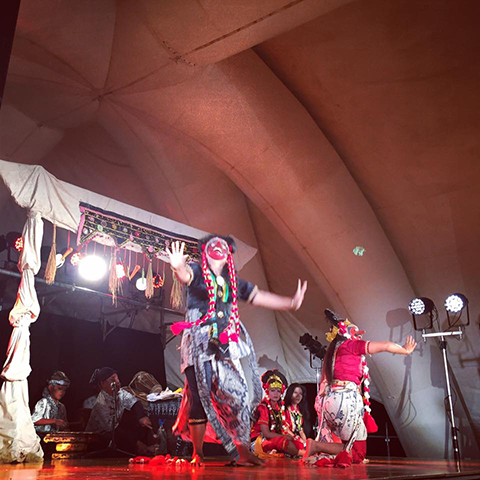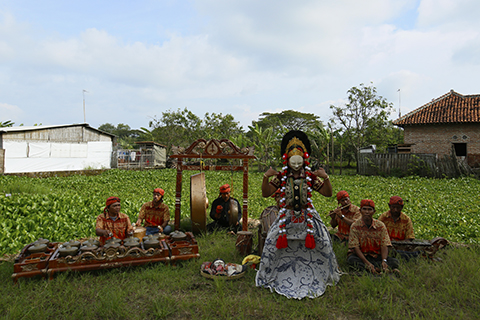
2014年に始まった三陸国際芸術祭は、地域の民俗芸能を通した復興支援を目的とするユニークな芸術祭。三陸のみならず、アジア各地からも多彩な芸能団体を招き、両者の競演や市民との交流をはかりながら、芸能を軸にした視点から地域や共同体のあり方を見つめ直してみようというコンセプトである。
Initiated in 2014, the annual Sanriku International Arts Festival aims at contribution to restoration of the Sanriku region after its devastation by the earthquake and tsunami in 2011, specifically though empowerment of traditional folk performing arts in the region. Inviting guests from different parts of Asia for a variety of exchange programs, the Festival’s emphasis falls on the function of communal practice of folk performing arts in the society.
第四回目となる今年は、インドネシアの西ジャワ州・インドラマユで仮面舞踊を上演しているアエルリ・ラシナの一座と、マレーシアのサバ州・センポルナからバジャウ族による舞踊と音楽のグループを招聘した。
Our international guests of this year’s edition were a mask dancer Aerli Rasinah and her troupe from Indramayu, West Java, Indonesia and the traditional dance and music ensemble of Bajau in Semporna, Sabah, Malaysia.
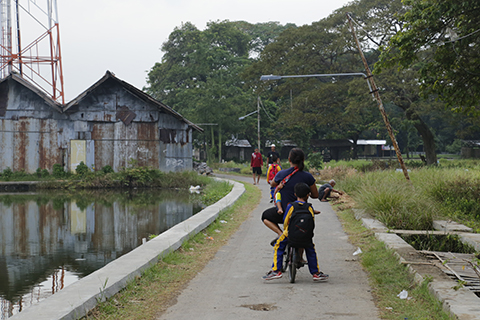
アエルリ・ラシナの一座が拠点を置くインドラマユは、西ジャワ州の沿岸部に位置するのどかな田園の町。16世紀にイスラムの聖者が作ったといわれる仮面舞踊はチルボンで発達した後、周辺地域にいくつもの流派を形成している。一人の踊り手が仮面を付け替えながら、貴種流離譚「パンジ物語」の登場人物を踊る芸能で、高貴で静謐な「パンジ」、そのライバルで荒型の「クラナ」、洗練された洒落者の「パミンド」といった、多彩な人物の性格の踊り分けが見所である。
Indramayu is a pastoral village located on the north coast of West Java. The origin of the mask dance allegedly traces back to the 16th century, when one of Islamic saints in Cirebon created it for propagation. Since then it has generated multiple local schools in the region. Putting masks of various characters from Panji’s tale, the dancer attracts the audience with her/his skill and playfulness of impersonating noble Panji, his brutal rival Kelana, or sophisticated dandy Pamindo, among others.
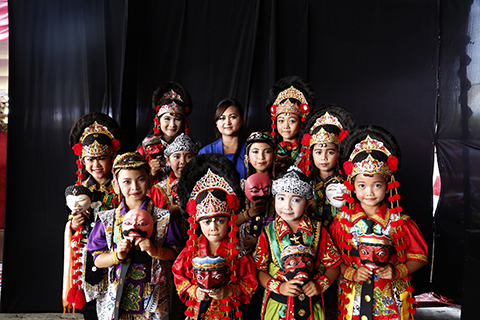
アエルリ・ラシナは2010年に亡くなった稀代の名手ミミ・ラシナの孫にあたる。ミミ・ラシナは、1990年代半ばに民族音楽学者たちによって「発見」されるまで20年以上も踊りから離れていたが、彼らの熱烈な支援で復活し、1999年の来日公演を端緒に国際的名声を博した。このミミが手塩にかけて育てたのがアエルリで、現在は祖母の跡を継ぎながら500人以上もの生徒を教えている。三陸国際芸術祭では、アエルリとその一座の他、生徒の中から高校生も一人招いて、地域に根差した芸能が脈々と継承されている様子を日本の観客に紹介することを意図した。
Aerli Rasinah is the granddaughter of Mimi Rasinah, the highly acclaimed mask dance master who has passed away in 2010. Mimi, after her 20 year suspension of career until the mid-1990s, was suddenly “discovered” by musicologists. They encouraged and persuaded her to return to stage, and it eventually led her to a fame immediately after her first international tour in Japan, 1999. In this period, Aerli received special attention and training from her, and now teaches over 500 students inheriting the great legacy. Sanriku International Arts Festival 2017 invited not only Aerli and her troupe but also one of her teenage students to show how the local culture is succeeded generation by generation.
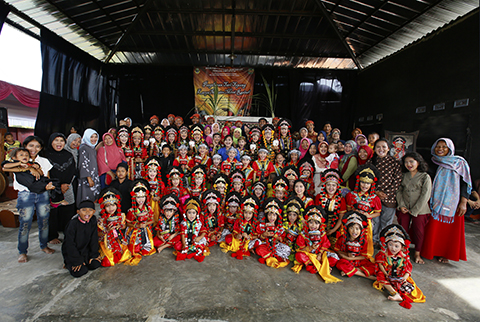
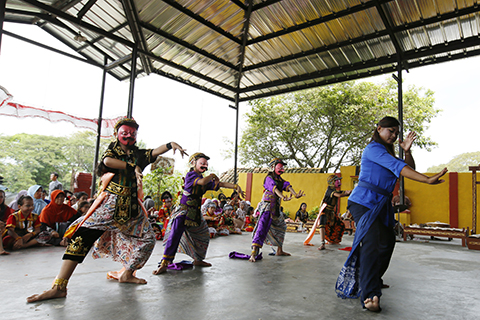
今年の芸術祭は、大船渡会場で二日間、八戸会場で一日、実施された(バジャウ族は大船渡のみの参加)。あいにく天候には悩まされたものの、神楽や剣舞、権現舞、鹿踊などといった多彩な三陸の芸能と、アエルリ・ラシナの一座、バジャウ族の芸能、さらにコンテンポラリーダンスやコミュニティダンス、地元のストリートダンスのグループなども参加し、大勢の観客が音楽や舞踊を楽しんだ。
This year’s festival was divided into two parts; August 11 and 12 in Ofunato-city, Iwate, and August 19 in Hachinohe-city, Aomori. Though haunted by rainy weather, numerous audience welcomed and enjoyed a wide array of folk performing arts in Sanriku such as Kagura, Kembai or Shishi-odori, together with mask dance from Indramayu, dance and music of Bajau, joined by performances by contemporary dance artists, community dance performance shared with local citizen participants, and local street dance group, among others.
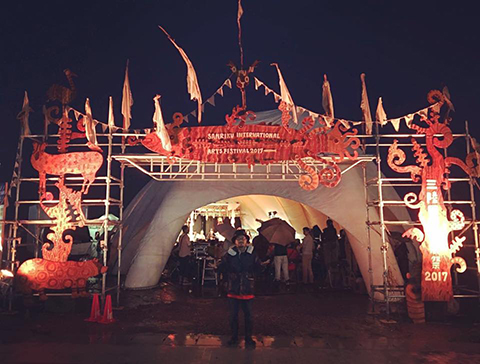
アエルリ・ラシナ一座の仮面舞踊は、大船渡では特設テントの中に建てられた舞台を使って、三陸の神楽と組み合わせる形で上演された。二日とも超満員となって熱気に満ちた客席は、八戸の鮫神楽、大槌の金澤神楽、宮古の黒森神楽とインドネシアの仮面舞踊を続けて楽しみ、大きな喝采を浴びた。面を用いて神的な存在を演じる芸能として、西ジャワの仮面舞踊と日本の神楽には多くの共通点があり、地域を超えた類似と差異を見つけながら楽しめる特別な機会となったといえよう。アエルリ・ラシナの一座は家族であり、9歳の子供や高校生も含んだ和気藹々とした上演には温かみがありながら、芸としての凄みも十分に感じさせた。また芸術祭では、アエルリの祖母であるミミ・ラシナをめぐるドキュメンタリー映画(Rasinah: The Enchanted Mask)も併せて上映し、世代から世代へと芸能が継承されている様子を紹介した。映画について「東北で芸能の継承に悩んでいる多くの人たちにも見てもらいたい」との感想も聞かれた。
In Ofunato, Aerli Rasinah and her troupe shared two evenings with three Kagura groups; Same Kagura from Hachinohe, Kanezawa Kagura from Otsuchi-town, and the renowned Kuromori Kagura from Miyako-city, at the stage built under huge temporary tent. Each evening, full-housed audience appreciated the rare combination. Especially Kuromori Kagura and Indonesian mask dance, both performing divinities using masks, revealed interesting comparison for curious audiences. Since Aerli’s troupe is composed of family members, including kids and high-school students, their performance had intimate atmosphere which gave a special kind of energy to their organic interplay. In addition to the stage performances, we also screened a 2003 documentary film on Mimi Rasinah directed by Rhoda Grauer, Rasinah: The Enchanted Mask, followed by additional new clip about Aerli’ current activity and its future prospect. According to one of the audience members, “this film is a must-see for many in Sanriku who struggle with the problem of traditional culture.”
